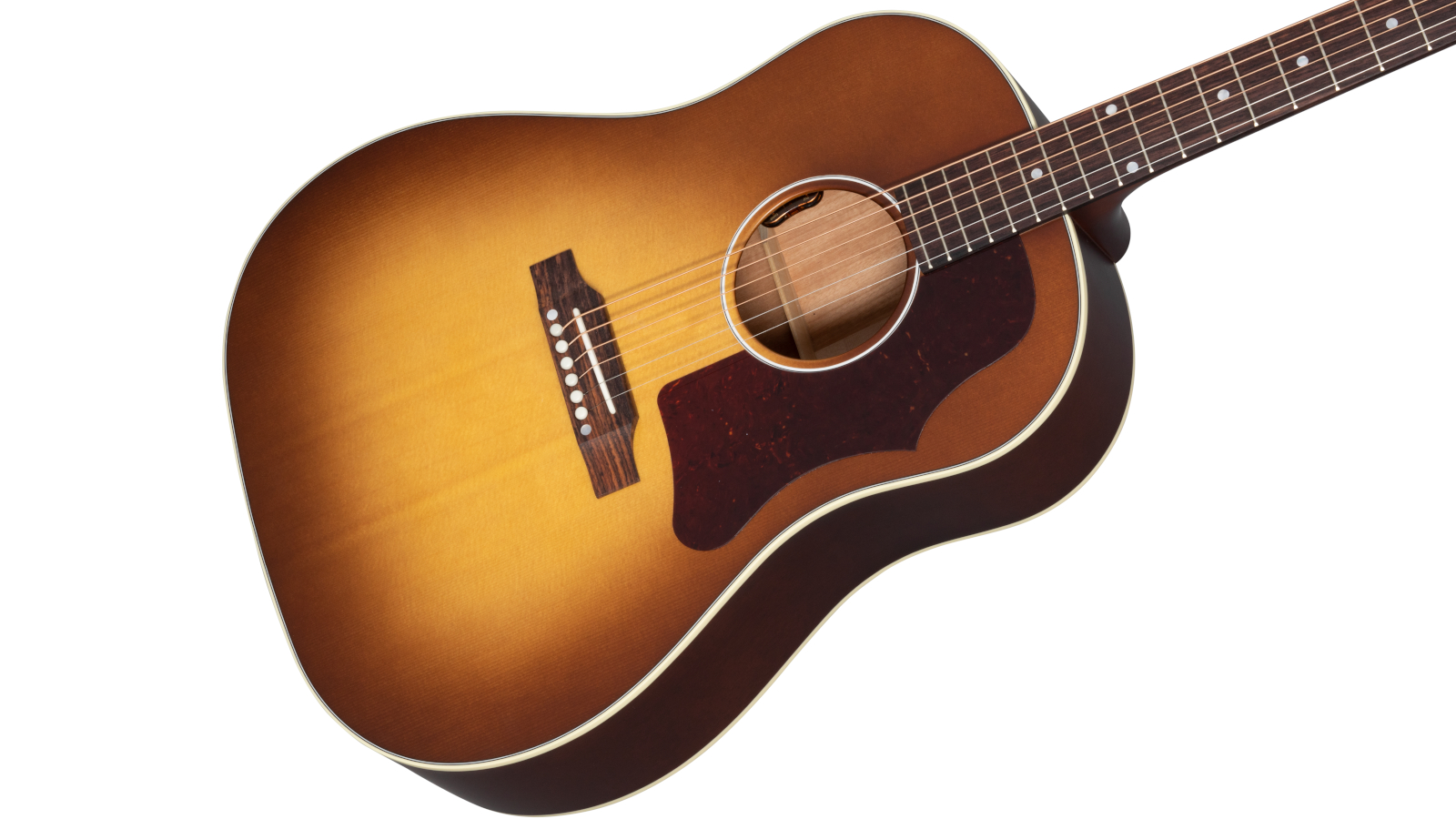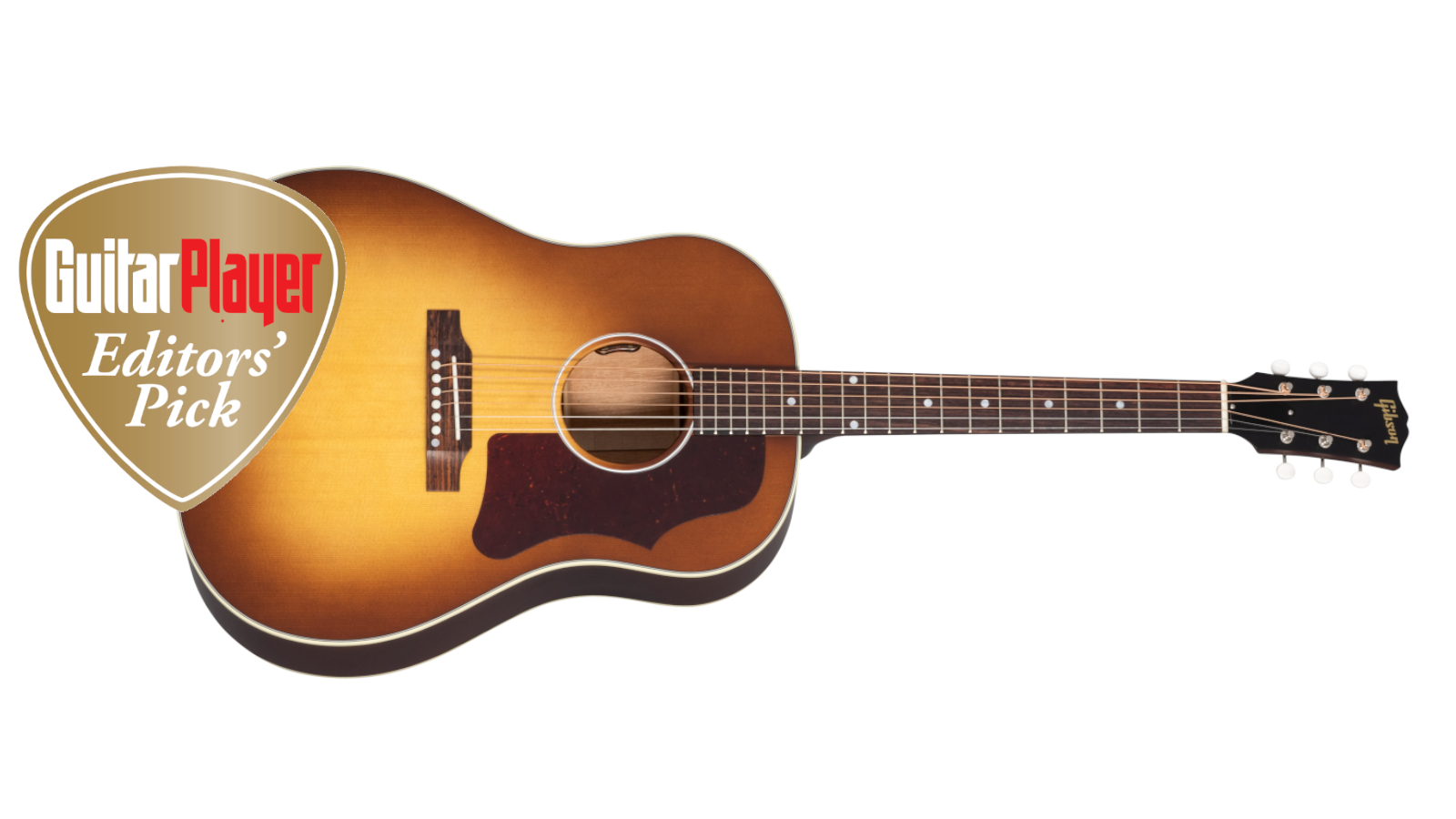GuitarPlayer Verdict
A cool new take on a timeless classic that sounds great, plays well and is within the reach of lots of players
Pros
- +
Cool muted colors and vintage vibe
- +
Full, resonant tone
- +
Nice playability
- +
Impeccable American craftsmanship at a reasonable price
Cons
- -
Some will always prefer dark and glossy
- -
Decal headstock logo rather than inlay
You can trust Guitar Player.
Creating a vintage-quality instrument with modern dependability at an affordable price is a lofty goal, and Gibson is shooting for the moon with the J-45 ’50s Faded, which features ’50s specs and a muted burst top with light finish.
To make the mission possible, the Nashville-based manufacturer has doubled the size of its “craftory” in Bozeman, Montana, where the entire acoustic guitar range is made using a whole lot of handiwork.
This J-45 represents the ’50s, which is a popular style for the model
Robi Johns
As Gibson president and C.E.O. James “J.C.” Curleigh explains, the expansion was the result of several converging factors. “There was a pent-up, consistent demand exceeding supply,” he says, “and then during the height of the pandemic, when people had extra time, the acoustic guitar became a thing. Orders went through the roof, so we’ve doubled down on capacity and modernization with the focus on quality and innovation.”
The budget Generation Collection, with its unique player port, opened Gibson’s acoustic doors to more guitarists, and the latest launch is the Original Collection Faded Series, the models from which come at a slightly nicer price than Standard.
Faded electrics have been around for more than a decade now, but the series is new to the Bozeman shop, and there’s more to Faded acoustics than meets the eye, as senior product development manager Robi Johns explains: “All three Faded acoustics are dreadnoughts, and each represents a classic period,” Johns says. “The precursor to the J-45 is the J-35, so it represents the ’30s.
“This J-45 represents the ’50s, which is a popular style for the model even though it was first introduced in 1942. The fancy, square-shouldered Hummingbird represents the ’60s. In addition to the color fading a bit over time, one of the big differences with a vintage instrument is the thick nitrocellulose finish wears away, which contributes to a more open sound and a less glossy feel, which many players appreciate because it’s less sticky.”

The J-35 and Hummingbird are only available with naturally finished Sitka tops, which didn’t seem quite as fun as the sunburst Sitka on the J-45. This workhorse is also Gibson’s all-time best seller, so we requested it. The instrument is designed to look, feel and sound like a solid-wood American guitar from the Eisenhower era, but with modern craftsmanship and quality onboard electronics, all at a price that wouldn’t make Ike roll over in his proverbial resting place.
A Faded costs about half of a custom Historic
Robi Johns
“The Faded finishing materials are a bit less expensive and the process takes less time, so we can pass those savings along,” Curleigh reveals. “It’s not a huge difference, but every $100 matters.”
A Faded ’50s lists for $350 less than a Standard J-45, and as Johns points out, “a Faded costs about half of a custom Historic, which is a painstakingly detailed recreation of an iconic model year. We use a thinner finish on those as well.”
Ultimately, the ’50s Faded top has its own top aesthetic. The vibe is time-honored, but not exactly like a ’50s J-45 hanging in the vintage section, with its original dark, glossy hues slightly diminished. The Faded is more like a purposely less vibrant version, as if it were exposed to the weather for a spell, or like choosing a muted color filter on a photo app.
Johns accurately describes it as “honey burst.” It’s especially interesting coming from Gibson, which is historically the most colorful major manufacturer. “We look beyond the guitar market for inspiration,” Curleigh explains. “More people are choosing matte finishes to decorate their new homes for a lived-in look, and fashion designers are using more muted colors.”
The former Levi’s executive acknowledges that the Faded concept is also similar to, say, stonewashed jeans, and adds, “I tend to love the Faded satin finish for what it is, and just for being different from my other guitars with the full nitro gloss finish. We can do both, and there is demand for both.”
I tend to love the Faded satin finish for what it is, and just for being different from my other guitars with the full nitro gloss finish
James “J.C.” Curleigh
In addition to the J-45 Faded’s finish of light nitrocellulose lacquer topped off with a satin touch, other elements that add to the ’50s aesthetic include a reverse belly-up bridge with ivory-colored Tusq bridge pins set in a bone saddle, white button Gotoh tuners complementing a white rosette, and white top and bottom bindings. Rather than a typical teardrop, the ’50s-style pickguard covers most of the lower bout below the sound hole.
The body is comfortable to hold, and the satin finish is nice and soft. The J-45 body is a full-sized dreadnought, but those rounded shoulders make it less broad and bulky compared to say, a Hummingbird.
The tone is a bit less booming than some dreadnoughts, but it has a strong, smooth low end to complement a punchy middle range focus and a pleasant top presence. Tonally, the big takeaway is tremendous vivaciousness, and although the top end isn’t particularly bright, it definitely has that Gibson jangle.
There is great holistic resonance, and it’s dynamically responsive. Harmonics readily occur. The sound is earthy and chunky with long sustain and pleasing overtones that kind of catch the ear by surprise on particularly resonant notes.
The factory action was spot-on
Sitting in my office on a big leather chair, with my left foot tucked under my right leg and the guitar straddling me and the chair, I could feel the pulse of each chord, and even each individual note, through the bones of my left foot and into my toes.
The amplified sound is nicely representative of the acoustic tone. The L.R. Baggs VTC pickup and preamp system are stealthy and simple. I set the tone at the middle notch with the volume near the max, and it sounded full and clear through a Fender Acoustic Junior GO.
The volume didn’t dip on any of the strings, as it so often does with some guitars. If anything, it seemed like the first string was a tad louder.
Playability is exceptional on its full, round neck, sporting a rather flat 12-inch radius. It’s got an old-time acoustic sensibility, meaning it certainly doesn’t feel at all like an electric guitar neck, but it is easy under the fingers. The factory action was spot-on. The frets are on the thin side, the intonation is good, and the tuners work well.
The J-45 ’50s Faded covers a ton of bases. It suits players seeking a vintage vibe and classic acoustic playability who also require a well-functioning instrument with fine electronics. It’s worthy of studio or stage use, and has an authentic back-porch appeal.
As for the Faded concept, I can dig it. I’ve always preferred my jeans to be a bit washed out, and the craftsmanship on this review unit is impeccable. Everything is even, edges everywhere are soft, and the cosmetics are unblemished.
We’re going to put out true, meaningful innovation that solves a question, a challenge, or presents a solution to a musician
James “J.C.” Curleigh
And, all things considered, the price is quite reasonable. For being a cool new take on a timeless classic that sounds great, plays well and is within the reach of lots of players, the Gibson J-45 Faded ’50s earns an Editors’ Pick Award.
Based on what Robi Johns says, it will be exciting to see what’s next from Gibson’s expanded acoustic shop. “In addition to a museum-like showroom, new offices and equipment, we’ve expanded the research and development department area in the new building,” Johns notes. “That’s a big part of Gibson’s history – always innovating.”
Adds Curleigh, “I’ve learned from experience that authentic brands like Gibson don’t play in novelty. We’re going to put out true, meaningful innovation that solves a question, a challenge, or presents a solution to a musician.
“In the words of Steve Jobs, ‘They didn’t know what they wanted, but when they get it, they can’t live without it.’ That’s meaningful innovation.”
Specifications
- NUT WIDTH: 1.73”, bone
- NECK: Mahogany
- FRETBOARD: Rosewood
- FRETS: 20
- TUNERS: Gotoh white button, Kluson-style
- BODY: Solid mahogany back and sides, solid Sitka spruce top
- BRIDGE: Mahogany, reverse belly
- ELECTRONICS: L.R.Baggs VTC
- FACTORY STRINGS: Gibson Coated Phosphor Bronze, 012–.053
- BUILT: USA
- WEIGHT: 4.2 lbs (as tested)
Visit Gibson for more information.
Jimmy Leslie has been Frets editor since 2016. See many Guitar Player- and Frets-related videos on his YouTube channel, and learn about his acoustic/electric rock group at spirithustler.com.
“I felt myself starting to cry.” Eric Clapton’s 'MTV Unplugged' Martin acoustic returns in two guises. But Slowhand’s affinity for the guitar brand began long before that seminal live performance
"I have a Mercury on the guitar now, which makes me very happy.” Brian May’s new signature Gibson SJ-200 features a subtle tribute to the late Queen singer Freddie Mercury















